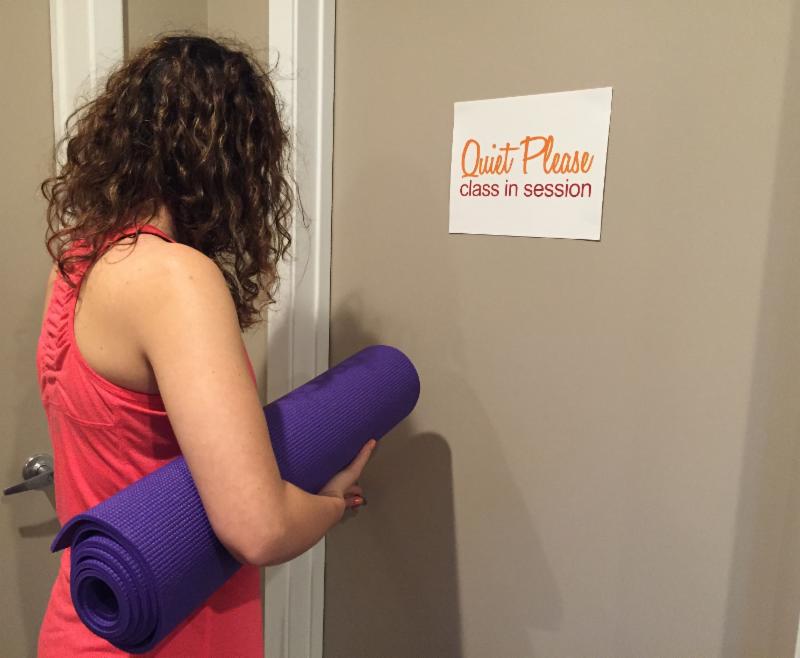Miss (Yoga) Manners
Chances are, when you visit a new place for the first time, you like have some idea about what to expect. And chances are, if you knew you were doing something that made others uncomfortable, you'd like to know about it.
This week's newsletter is dedicated to just that - etiquette. It's a quick and friendly review of etiquette tips to make sure you (and everyone around you) feel comfortable in our (or any!) yoga studio.
Shoes and Personal Belongings
When you visit a yoga studio, you'll likely be expected to remove your shoes, for a couple of reasons. One is to help keep the floors clean for everyone, the other is that shoes can affect your ability to balance well. If you're uncomfortable removing your shoes, it is ok to wear clean socks for the yoga practice, but please note that socks can feel a bit slippery in some poses.
At The Yoga Room you can place your shoes on the shoe shelf in the lobby. Any additional personal belongings, such as your purse, wallet, or keys, may be placed in a cubby in your classroom for safe keeping during class.
Arrival Time
Please arrive at least 5-10 minutes before your class begins. This gives you time to take off your shoes, handle any needed paperwork or payment, and visit the restroom before class begins. When a student arrives late for class, it can be disruptive to the rest of the students who have set down and organized their mats and props, and it can also be disruptive to the teacher's train of thought.
Cell Phones, Pagers, and Smart Watches
Unless you are a medical professional who is on call, please leave your cell phone in your car or make sure it is switched off or to airplane mode. Putting your phone in vibrate mode is not a good choice, as a vibrating cellphone can be a distraction in an otherwise quiet class, especially during relaxation or breathing practices. Let the yoga practice space be a safe haven where you take one hour to unplug from technology and connect with your body, your mind, and your spirit.
Clothing
Wear modest clothing for yoga practice. Yoga pants or longer shorts and a t-shirt or tank top are appropriate. Please note that the fabric of some yoga pants becomes transparent when stretched. You can test your yoga pants by stretching the fabric over your outstretched hand and observing how much light shines through. Most people are comfortable with a top that is slightly form fitted so that it stays in place in the various yoga postures.
Talking Between Classes
Since we have two practice rooms at The Yoga Room, there's often one class (or an Individual Instruction appointment) in session when the other class lets out. Loud talking in the lobby, the classroom, and even outside in the breezeway, can be disruptive to the concentration of both the students and the teacher who are in class. Please remember to use a quiet voice when speaking with classmates, teachers, and the reception staff.
Talking During Class
In a typical yoga class, the teacher speaks and sometimes demonstrates the instructions, and the students listen, watch, and practice. Students are encouraged to hold questions or comments until the end of class. Of course, if a posture is painful or uncomfortable, the student should quietly call the teacher over to seek additional guidance.
In workshop-type instructional environments, the teacher may ask direct questions to encourage reflection and discussion for the benefit of everyone.
Chewing Gum
Please refrain from chewing gum during class. Chewing gum disrupts your breathing and creates a distraction from your practice.
Perfumes, Scents, and Odors
Breathing is a very important aspect of the yoga practice. We breathe consciously during the āsana practice, in relaxation, and of course during prānāyāma (breathing practice). As such, it's important for the air in the room be fresh and free of any type of scent or odor.
Please make sure that your body is fresh and clean, and please refrain from wearing perfume, cologne, scented lotions, essential oils, or any other type of scent. You may love your favorite scent and believe that it is mild and pleasant, but one or more of your classmates, or even your teacher, may be sensitive or allergic to even the mildest of scents. Scents are even known to trigger migraines in some people.
Yoga Mats
Please keep your yoga mat clean by washing it periodically with a tiny bit of laundry or dish soap. You are welcome to use our mat spray between washes. It is located in the basket with our rental yoga mats.
Please be respectful of others’ yoga mats and do not step on them without permission.
Miss Manners' Yoga Philosophy for Advanced Practitioners
It is interesting to observe the relationship between the purpose of yoga and yoga studio etiquette. The purpose of yoga is to quiet the mind, which means that we are training the mind to be calm and remain undisturbed by everyday sensory distractions. Yoga etiquette addresses potential sensory distractions that may arise in a yoga studio environment.
- Shoes affect cleanliness and touch/balance.
- A person's late arrival affects that person's stress level and the sight and hearing senses of the other practitioners.
- The beeping and buzzing of cellphones affect the sense of hearing.
- Clothing affects the sense of touch and can also be a mental distraction.
- Talking occupies the mind of the speaker and the hearing sense of the listener.
- Chewing gum creates a physical/taste/breathing distraction for the chewer and a sound and potential sight distraction for the other practitioners.
- Perfumes, scents, and odors distract the sense of smell and can also cause a physical response (migraine headache).
- A dirty yoga mat can be a visual and possible smell distraction for oneself and one's fellow practitioners.
We are all affected by so many sensory stimuli in our daily lives: traffic, internet, news, loud music, pollution, discussions, debates, etc. The yoga studio is an oasis where we can soothe our senses and capitalize on the opportunity to train our minds and our ability to focus, so that little by little, we become liberated from sensory distraction.
I know that philosophy discussion was pretty deep - I'd love to hear any comments, questions, or observations you may have about yoga etiquette and/or yoga philosophy. Please email me at zelinda@rryogaroom.com if there's anything you'd like to share or discuss.
And please feel free to forward this to any friends who are thinking about starting a yoga practice. Hopefully, knowing what to expect in a yoga studio setting will help them feel comfortable and confident to try their first class.
Hope to see you soon!
Have You Been Unintentionally Stealing?
Earlier this week we made a new-ish student pretty upset with us. She arrived several minutes late for a class and the staff at our front desk would not let her into the class. Of course we never want to exclude our students from class or make them angry (after all, our mission is Yoga for EveryBody), but we do want to protect the sacredness of the time and space of the yoga class.
Our Yoga Etiquette guidelines on our website recommend that students “Arrive a few minutes before your class. Late arrivals are disruptive to the teacher and the students who have set down their mats and settled in for practice.”
Given the increasing number of late arrivals we’ve had in recent weeks, I think it’s time to shine a light on this guideline and explain in more detail why it’s so important that everyone arrive on time.
 According to the yogic concept Asteya, being late for an appointment or meeting is a form of stealing. It’s stealing people’s time. Allow me to explain…
According to the yogic concept Asteya, being late for an appointment or meeting is a form of stealing. It’s stealing people’s time. Allow me to explain…
Stealing from Classmates
When people come to a yoga class, they have planned and committed time for their yoga practice, for their self-care. One of the main reasons people come to yoga is to restore some peacefulness into their hectic lives. When a person arrives late to class, they create disruption and unintentionally steal from their classmates’ peaceful experience.
Depending upon how late the person arrives, their entry into class may have different repercussions.
If the class has already begun, everyone has already set up a space for their mat and props. When a person comes in late, depending on the size of the class, some classmates may need to stop their practice, get up, and reposition their mat and props to make space for the late person.
A late arrival might interrupt the centering practice. That means that just as people are doing the work of shifting their awareness out of their heads and settling into their bodies, the late person’s arrival, even if they try to minimize disruption, can abruptly bump their classmates’ awareness back into their minds.
And from a more literal perspective, when a person arrives late they are stealing from their classmates’ financial investment in the class. Our classes are defined to be 60 minutes long (for the most part), and people expect 60 minutes of instruction.
When a person arrives late, their classmates are disrupted, the teacher’s train of thought is disrupted, thus disrupting the quality and flow of the class. As a result, unfortunately, the students do not receive the full 60 minutes of instruction they expected.
Stealing from Themselves
A student’s late arrival might mean that they come into class when the yoga practice has already begun. If this is the case, the late student is also stealing from their own experience.
The teacher may not have time to check in with the late student to find out about any injuries, issues, or conditions they may have that day, so the teacher may not provide a practice that is 100% appropriate and beneficial.
Or, the late student may miss the warm up and need to jump into the practice at a point when the poses have become inappropriately challenging for a person who just walked in the door. This may, unfortunately, lead to a less-than-great practice or even an injury.
Stealing from the Teacher
When a student comes in late for class, it can cause a lot of stress for the teacher. First, the teacher might need to help the latecomer find a spot for their mat. Then, in order to help the student begin their practice without further delay, and in an effort to minimize disruption, the teacher may need to fetch the student’s props *while* they continue teaching *and* keeping an eye on all the students to make sure they’re understanding the instructions and their alignment is correct and safe.
The teacher may worry that the late student has not had time to properly warm up and is entering the practice at a point when the poses have already become challenging. They may be concerned that they do not know whether the student has any injuries, issues, or conditions that may affect their practice. All of these concerns and efforts steal the teacher’s peace.
If the teacher can find time to check in with the student, they may realize that the practice they planned and began teaching is not appropriate for the late student, and they may have to scramble to change their lesson plan mid-class. This can be extremely challenging and stressful.
I can tell you from personal experience that on a few occasions when I’ve taught a class where many of the students are dealing with serious issues in their bodies (knee replacements, herniated discs, carpal tunnel syndrome, fibromyalgia, recovering from a car accident), and I’ve figured out a lesson plan and begun teaching a practice that is appropriate and beneficial for everyone in the class, if a person comes in late and they have a new issue I need to take into consideration, it can completely throw off the rest of the class.
Without an opportunity to stop, collect my thoughts, and replan the class, the rest of the practice feels like a disaster, a random assortment of yoga poses that really doesn’t serve anyone. The quality of the instruction really suffers, and you can be sure that this kind of situation will really steal the teacher’s peace.
So…
Having students arrive late for class is a really difficult situation. Of course we want to be welcoming and inclusive, but we also want to protect everybody's experience. And in order to do that we need to set some clear expectations.
Please make every effort to arrive early enough that you can set down your belongings, check in, use the restroom if needed, drink some water if you want to, select the props you want for class, and be on your mat and ready to begin at the time the class is set to start.
Usually, arriving 10-15 minutes before your class time is perfect. If you have a little extra time you can relax on your mat for a few minutes and start getting present for your practice.
If it’s your first visit to the studio and you have trouble finding us, or if you are a regular student who has gotten stuck in unexpected traffic or have had some other unforeseen issue, and you know you’re going to be late, please give us a call (512-318-2112) if you can so that we can be prepared for your late arrival.
And please know that we absolutely cannot allow anyone to enter a class more than 5 minutes late because we want to make sure we’re providing a high quality experience and keeping you safe.
And by the same token, please plan to stay until the end of class. Packing up and leaving before the end of class causes the same kind of disruption as someone arriving late.
We very much appreciate your understanding on this, and we look forward to seeing you soon!

XO, Zelinda
P.S. We'd love to hear from you on this. Please feel free to leave a comment here or send us an email if you'd prefer to send a private note.




